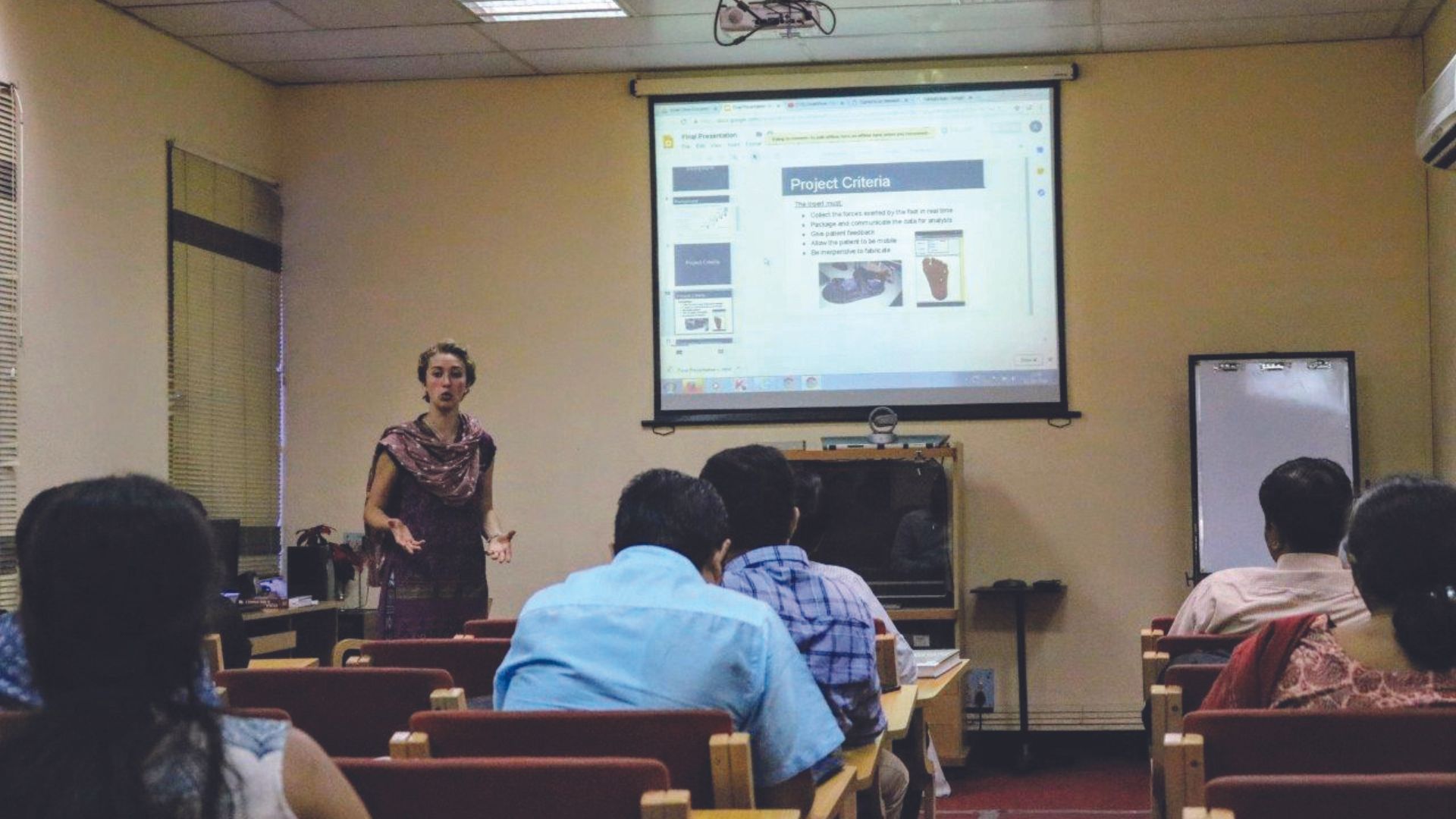Fulbright-Nehru Student Researcher Kayla Huemer's project focused on developing a low-cost solution to identify patients at highest risk of developing diabetic foot ulcers.
March 2020

Kayla Huemer presents her work on diabetic foot ulcers to doctors from across India, who were part of a week-long course at Christian Medical College (CMC) Vellore. Courtesy Kayla Huemer
As the prevalence of diabetes increases rapidly across the world, complications like diabetic foot ulcers are expected to rise as well. Unmanaged diabetes can cause nerve death in the extremities, leading to a loss of pain sensation and an unbalanced gait, which may lead to pressure ulcers on patients’ feet. Without proper treatment, these ulcers could become infected and eventually necessitate amputations. Untreated diabetic foot ulcers are one of the leading causes of non-traumatic amputations worldwide. This is a particular point of concern in India, which is home to the second-largest number of adults with diabetes worldwide, according to the latest data from the International Diabetes Federation.
Fulbright-Nehru Student Researcher Kayla Huemer’s project in 2018-19 focused on developing a low-cost solution to identify patients at highest risk of developing foot ulcers. She came across thermal patterns in the feet of the diabetes patients she was working with, and began assessing the use of thermal imaging to predict ulcer development. She hopes this information will enable health care workers to initiate treatment sooner, to prevent the ulcers from ever happening.
Huemer’s interest in medical devices goes back several years. She had dreamed of becoming a medical doctor until she took an engineering course at the end of her freshman year of college and realized it was the innovation of medicine that interested her more than anything else. “I enrolled in biomedical engineering and became very passionate about the projects I collaborated on with doctors,” she says. “I’d sit down and talk with these doctors, sometimes for hours on end, to understand the ideas they had for novel medical devices. I’d then get to put my engineering skills to work—designing circuits, embedding sensors, writing primitive phone applications. It’s always a privilege to work with doctors because I get to bring their ideas for better medicine to life.”
In 2016, Huemer traveled to India under the S.N. Bose Scholars Program for a research internship at the Indian Institute of Science in Bengaluru. This student exchange program between institutions in India and the United States is a partnership between the Indo-U.S. Science and Technology Forum, the Government of India’s Department of Science and Technology, and others.
In Bengaluru, Huemer worked on wearable technology meant to improve therapy of diabetic foot ulcers. After developing the device that summer, Huemer applied for a Fulbright Research Fellowship, outlining the need for such a device in the context of the wide prevalence of diabetes in India. “After graduation, I had no other desire than to continue working in low-income settings on health care issues,” she says. “To this day, receiving a Fulbright Fellowship to work on this issue that I’m passionate about was the single most affirming moment in my career as a young biomedical engineer.”
For nine months, starting August 2018, Huemer worked with a team at Christian Medical College Vellore to create a wearable technology to aid in the therapy of diabetic foot ulcers. The device would map the pressure in the feet of patients with ulcers, allowing doctors to understand how they should alleviate the pressure to allow the wounds to heal. However, while observing patients coming to the clinic, Huemer realized that many arrived past the point of any help. Their infections were too deep to treat and gave doctors no choice but to amputate. She felt that instead of developing a device to help patients heal, she needed to focus on preventing the ulcers in the first place, especially in low-resource settings.
Searching for a different solution, Huemer noticed during her time in the clinic that just prior to ulceration, a patient’s foot would have slight inflammation and be warm in the pre-ulceration area. This led to a new idea—to focus on temperature—prompting her to take hundreds of thermal images of the patients’ feet. “I’m now working with this data back in the U.S., as an affiliate researcher at the University of Wisconsin-Madison, to identify pre-ulceration warning signs in the thermal scans. I’ve brought six new students onto the project and, as of now, four of the students are set to return to India to continue the work next summer.” The students hope to travel on the Research Internships in Science and Engineering (RISE), S.N. Bose and other funding opportunities for international research.
Looking back at her time in India, Huemer says, “I absolutely love it. India truly feels like a home and I miss the people whenever I’m away. The color of the culture, and the diversity of the people in language, food and customs makes it a country of such contrasts! It’s humbling to get to work on unmet health care needs and India specifically has my heart. I see so much growth in the coming decades for health care within the country and I desire to dedicate my career to bringing to light the issues it’s facing.”
Megan McDrew, based in Monterey, California, is a professor of sociology at the University of California, Santa Cruz, and the University of California, Merced.
COMMENTS